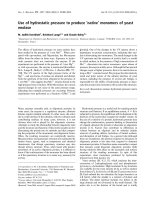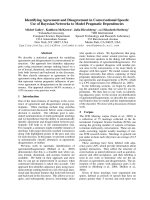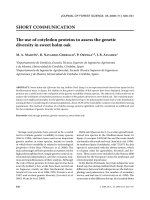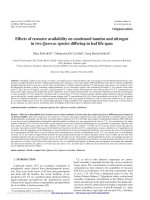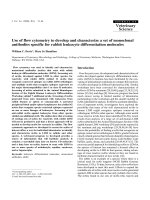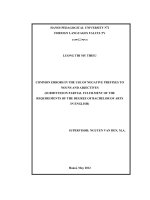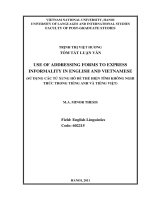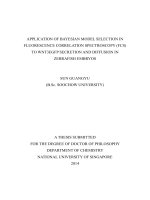use of nondestructive spectroscopy to assess chlorophyll and nitrogen in fresh leaves
Bạn đang xem bản rút gọn của tài liệu. Xem và tải ngay bản đầy đủ của tài liệu tại đây (12.01 MB, 222 trang )
USE OF NONDESTRUCTIVE SPECTROSCOPY TO ASSESS
CHLOROPHYLL AND NITROGEN IN FRESH LEAVES
PINGHAI DING
related OW either from visible or red edge region in combination with a reference
wavelength (RW) from the near infrared (NIR) region (750 – 1100 nm) that was sensitive
to leaf texture but insensitive to Chl as the form of a simple ratio (R
RW
/R
OW
) or
normalized difference vegetation index (R
RW
– R
OW
)/( R
RW
+ R
OW
). With RW, the
differences in reflectance in the visible and red edge regions caused by variation in leaf
texture or other optical properties could be eliminated. This was particularly important
when the R
2
of a single-wavelength index was small for Chl or N measurement (e.g.
R
2
<0.8000 for Chl or R
2
<0.6000 for N).
Parameters used by hand-held Chl meters (CCM-200, SPAD-502, and CM-1000)
affected their accuracy for Chl and N assessment. Our results showed that SPAD-502 was
more accurate than CCM-200 and CM-1000 for assessing Chl and N in fresh leaves. The
Chl-sensitive wavelength used by CM-1000 (700 nm) was more accurate for estimating Chl
than the wavelengths used by SPAD-502 (650 nm) and CCM-200 (660nm); however, we
found that variation in sampling distance, orientation, light intensity, and the inconsistency of
light intensity between ambient light sensor and the target leaf made the CM-1000 less
accurate than the other two meters. Using the indices and OW determined through our
research, we developed three prototype meters that were more accurate than or similar to
the commercial hand-held meters in measuring Chl or N in fresh leaves. Among them,
the prototype-III was more accurate than all the commercial hand-held meters for Chl and
than the CM-1000 for N assessments across all the species we tested.
©Copyright by Pinghai Ding
December 5, 2005
All Rights Reserved
Use of Nondestructive Spectroscopy to Assess Chlorophyll
and Nitrogen in Fresh Leaves
by
Pinghai Ding
A DISSERTATION
submitted to
Oregon State University
in partial fulfillment of
the requirements for the
degree of
Doctor of Philosophy
Presented on December 5, 2005
Commencement June 2006
UMI Number: 3207147
3207147
2006
UMI Microform
Copyright
All rights reserved. This microform edition is protected against
unauthorized copying under Title 17, United States Code.
ProQuest Information and Learning Company
300 North Zeeb Road
P.O. Box 1346
Ann Arbor, MI 48106-1346
by ProQuest Information and Learning Company.
My Ph.D. program would not have been completed without the help and support
of many people. First and foremost, I want to thank my major professor, Dr. Leslie H.
Fuchigami, for providing the opportunity to pursue my Ph.D. degree at Oregon State
University, for giving me considerable independence to explore my interests, and for his
invaluable advice, support, and encouragement. I also want to thank the other members of
my graduate committee, Drs. Carolyn Scagel, Robert Linderman, Carmo M.
Vasconcelos, John A. Young, and Thomson K. Plant for contributing ideas, allowing me
the freedom to use their laboratory equipment, providing countless support for my
research, and review and edit this thesis.
To all the faculty, staff, and graduate students in the Department of Horticulture, I
thank you. The environment in the department makes OSU a great place to work. Special
appreciation to Scott Robbins, Dr. Lailiang Cheng, Yongjian Chang, Shufu Dong, Guy
Barnes, Rengong Meng and the members of our lab group: Minggang Cui, Guihong Bi,
Yueju Wang, Srisangwan Laywisadkul, Yuexin Wang, and Michelle Hayes for their help
and friendship.
Thanks to the Washington Tree Fruit Research Commission, Oregon Association
of Nurserymen, and California Fruit Tree, Nut Tree, Grapevine Advisory Board and
USDA/ARS for providing the financial support. Without their support, this research
would not have been possible.
Lastly, I want to express my deepest gratitude to my wife, Cuili Bian, for her
patience, understanding and support, and to my son, Tong Ding, for his love, and to my
family back in China for their support across the Pacific.
TABLE OF CONTENTS
Page
CHAPTER 1. INTRODUCTION 1
CHAPTER 2. LITERATURE REVIEW 7
2.1 Properties of light as electromagnetic radiation 7
2.2 Interactions between leaves and visible, red edge and infrared radiation 8
2.3 Measuring plant leaf and EMR interactions 11
CHAPTER 3. SIMPLE LINEAR REGRESSION AND WAVELENGTH
SENSITIVITY LYSIS USED TO DETERMINE THE OPTIMUM
WAVELENGTH FOR THE NONDESTRUCTIVE ASSESSMENT
OF CHLOROPHYLL IN FRESH LEAVES USING SPECTRAL
REFLECTANCE 35
3.1 Abstract 35
3.2 Introduction 36
3.3 Materials and methods 39
3.4 Results and discussion 43
3.5 Conclusions 49
3.6 References 51
CHAPTER4.OPTIMUM WAVELENGTH IDENTIFICATION AND INDICES
EVALUATION FOR NONDESTRUCTIVE ASSESSMENT OF
CHLOROPHYLL IN FRESH POPLAR LEAVES USING
SPECTRAL REFLECTANCE 62
4.1 Abstract 62
4.2 Introduction 63
4.3 Materials and methods 65
TABLE OF CONTENTS (Continued)
Page
4.4 Results and discussion 69
4.5 Conclusions 76
4.6 References 77
CHAPTER 5. EFFECT OF LEAF PROPERTIES ON NONDESTRUCTIVE
ASSESSMENT OF CHLOROPHYLL IN FRESH LEAVES
USING SPECTRAL REFLECTANCE 92
5.1 Abstract 92
5.2 Introduction 93
5.3 Materials and methods 95
5.4 Results 98
5.5 Discussions 103
5.6 Conclusions 109
5.7 References 110
CHAPTER 6.VARIABILITY IN ESTIMATES OF CHLOROPHYLL AND
NITROGEN BY TRANSMISSION AND REFLECTANCE
USING HAND-HELD METERS IS A FUNCTION OF METER
PARAMETERS AND SAMPLING TECHNIQUE 122
6.1 Abstract 122
6.2 Introduction 123
6.3 Materials and methods 126
6.4 Results 133
6.5 Discussions 137
6.6 Conclusions 142
TABLE OF CONTENTS (Continued)
Page
6.7 References 143
CHAPTER 7. DISSERTATION SUMMARY 166
BIBLIOGRAPHY 169
APPENDICES 181
APPENDIX A. DEVELOPMENT OF A TRANSMMISION HAND-HELD
METER FOR ASSESSING CHLOROPHYLL AND
NITROGEN IN FRESH LEAVES 182
APPENDIX B. CONCENTRATION OF TOTAL CHLOROPHYLL
(CHL) AND NITROGEN (N) IN LEAVES OF
DIFFERENT GENOTYPES TESTED IN THE STUDY 203
LIST OF TABLES
Table Page
2.1 Published indices used for leaf-level assessment of chlorophyll (Chl)
and remote sensing for vegetation characterization 31
3.1 Maximum (peak) coefficient of determination (R
2
) values for
the relationship between reflectance values and chlorophyll
concentration at each wavelength from 300 to 1100 nm for 60
leaves of each genotype 54
4.1 Published indices used for leaf-level or canopy-level chlorophyll
(Chl) assessment in remote sensing 81
4.2 Peak range and optimum wavelengths (OW
Chl
) for assessment
of different chlorophyll (Chl) types (Chl a, Chl b and Chl a+b)
in poplar leaves 82
4.3 The accuracy of using published indices and calibration equations
for assessing chlorophyll a (Chl a) in poplar leaves 83
4.4 The accuracy of using published indices and calibration equations
for assessing chlorophyll b (Chl b) in poplar leaves 84
4.5 The accuracy of using published indices and calibration equations
for assessing chlorophyll b a+b (Chl a+b) in poplar leaves 85
4.6 The accuracy and calibration equations of the published indices
after the Chl-related wavelength replaced by the optimal wavelength
for assessing chlorophyll (Chl a, Chl b and Chl a+b in poplar leaves 86
4.7 Coefficients of determination for relationships between concentrations of
chlorophyll (Chl a, Chl b, and Chl a+b) and reflectance values for indices
developed with optimal wavelength for chlorophyll assessment of (OW
Chl
)
in visible and red edge regions respectively 88
5.1 Correlation coefficients (R
2
) and root mean square error (RMSE) of
simple linear regression for the relationship between chlorophyll
(Chl a, Chl b and Chl a+b) concentrations in leaves from five plant
species and reflectance values at optimum wavelength (OW
Chl
) in
the visible and red edge regions of the spectrum for estimating
different chlorophyll (Chl) 113
LIST OF TABLES (Continued)
Table Page
5.2 Correlation coefficients (R
2
) and root mean square error (RMSE)
of simple linear regression for the relationship between chlorophyll
(Chl a, Chl b and Chl a+b) concentrations in leaves of four apple
cultivars and reflectance values at optimum wavelength (OW
Chl
) in
the visible and red edge regions of the spectrum for estimating
different chlorophyll (Chl) 114
5.3 Correlation coefficients (R
2
) and root mean square error (RMSE)
of simple linear regression for different indices used to estimate
chlorophyll (Chl) in leaves of five species 115
5.4 Leaf pigment concentrations of chlorophyll a (Chl a); chlorophyll b
(Chl b); total chlorophyll (Chl a+b); anthocyanins (Anth); carotenoids
(Caro) and their and ratios in leaves of five species and the correlation
coefficients (R
2
) and root mean square error (RMSE) for the relationships
between pigment concentrations and reflectance at the optimum
wavelength (OW
Chl
) for assessing chlorophyll (Chl) 116
6.1 Variability in output values obtained from ‘Fuji’ apple leaves with
different chlorophyll (Chl) and nitrogen (N) concentrations using three
hand-held meters 147
6.2 Variability in estimated chlorophyll (Chl) concentrations of ‘Fuji’
apple leaves with different Chl concentrations obtained using
three hand-held meters 148
6.3 Variability in estimated nitrogen (N) concentrations of ‘Fuji’
apple leaves with different N concentrations obtained using
three hand-held meters 149
6.4 Correlation coefficients (R
2
) and root mean square error (RSME)
of different wavelength for estimating chlorophyll (Chl) in leaves
of three plant species by transmission and reflectance 150
6.5 Correlation coefficients (R
2
) and root mean square error (RSME)
of different wavelengths for estimating nitrogen (N) in leaves of
three plant species by transmission and reflectance 151
6.6 Correlation coefficients (R
2
) and root mean square error (RSME)
from hand-held meters and optimum wavelength (OW
Chl
) related
LIST OF TABLES (Continued)
Table Page
indices for estimating chlorophyll (Chl) concentrations in leaves
of poplar, apple, and almond 152
6.7 Correlation coefficients (R
2
) and root mean square errors (RSME)
from hand-held meters and optimum wavelength (OW
N
) related
indices for estimating nitrogen (N) concentrations in leaves of
poplar, apple, and almond 154
6.8 Correlation coefficients (R
2
) and root mean square error (RSME)
for relationships between leaf chlorophyll (Chl) concentrations
and output from different hand-held meters used to estimate Chl
in leaves of different genotypes 156
6.9 Correlation coefficients (R
2
) and root mean square error (RSME)
for relationships between leaf nitrogen (N) concentrations and
outputs from different hand-held meters used to estimate nitrogen
(N) in leaves different genotypes 157
LIST OF FIGURES
Figure Page
2.1 Lights and their properties as electromagnetic radiation (EMR) 32
2.2 Reflectance and transmittance spectra of (A) fresh and
(B) dry poplar leaves 32
2.3 Red (R), green (G), blue (B), and infrared (IR) electromagnetic
radiation (EMR) interacting with structural components of a leaf 33
2.4 Stochastic radioactive transfer model of interactions between leaf
structural components and electromagnetic radiation (EMR) 34
3.1 Coefficients of determination (R
2
) and root mean square errors (RMSE)
for the relationships between chlorophyll concentrations (Chl a, Chl b
and Chl a+b) and reflectance values at 1 nm intervals from 300nm to
1100 nm in leaves of apple (A, D), poplar (B, E) and almond (C,F) 55
3.2 Original reflectance spectra (A), reflectance difference curves (B) and
reflectance sensitivity curves (C-F) of four apple (Malus domestica
'Fuji') leaves (S1-S4) with different total chlorophyll concentrations
(ChlT1-ChlT4) 56
3.3 The original reflectance spectra (A), reflectance difference curves (B) and
reflectance sensitivity curves (C-F) of four poplar (Populus trichocarpa x
P. deltoids) leaves (S1-S4) with different total chlorophyll concentrations
(ChlT1-ChlT4) 57
3.4 The original reflectance spectra (A), reflectance difference curves (B)
and reflectance sensitivity curves (C-F) of four almond (Prunus dulcis
‘Nonpareil’) leaves (S1-S4) with different total chlorophyll concentrations
(ChlT1-ChlT4) 58
3.5 The original reflectance spectra (A-C) of four leaves (S1-S4) with different
total chlorophyll concentrations and the corresponding the 1
st
derivative
spectra (D-F) for the same leaves 59
3.6 Comparison of peaks obtained from three methods used to select optimum
wavelengths for assessing chlorophyll (Chl) concentrations in leaves of
apple, poplar, and almond 60
3.7 Relationship between total chlorophyll concentration (Chl a + b) in poplar
(P. trichocarpa x P. deltoids) and reflectance values at optimum wavelengths
LIST OF FIGURES (Continued)
Figure Page
selected by three different methods 61
4.1 The (A) original reflectance spectrum from poplar leaves with different
chlorophyll concentrations (Chl1-Chl4), the (B) coefficients of
determination (R
2
) and (C) root mean square error (RMSE) for
relationships between reflectance values and concentrations of
different Chl types (Chl a, Chlb, and Chl a+b) of 72 leaf samples,
and the wavelength sensitivity of (D) Chl a, (E) Chl b and (F).
Chl a+b at 1 nm intervals from 300 to 1100nm in poplar leaves 89
4.2 The coefficients of determination (R
2
) (A, B, and C) and root mean square
errors (RMSE) (C, D and E) from simple linear regressions between
transformed reflectance values based on simple ratio and concentrations
of chlorophyll (Ch a, Ch b and Ch a+b) in poplar leaves from 300 nm to
1100 nm with 1 nm intervals and sample number n=72 90
4.3 The coefficients of determination (R
2
) (A, B, and C) and root mean
square errors (RMSE) (C, D and E) from simple linear regressions
between transformed reflectance values based on the normalized
difference vegetation index (NDVI) and concentrations of chlorophyll
(Ch a, Ch b and Ch a+b) in poplar leaves from 300 nm to 1100 nm
with 1 nm intervals and sample number n=72 91
5.1 Reflectance spectra from two poplar (Populus trichocarpa × P.
deltoides) leaves (A) and two apple (Malus domestica ‘Fuji’)
leaves (B) with similar concentrations of total chlorophyll 118
5.2 Reflectance spectra from the same leaf of (A) ‘Fuji’ apple (Malus
domestica ‘Fuji’) and (B) purple leaf flowering cherry (Prunus
blireiana) with different water status (% water based on fresh weight) 119
5.3 Relationships between reflectance at 550 nm, 675, nm and 720 nm
wavelengths and total chlorophyll (Chl) concentrations in the leaves of
‘Fuji’ apple (A-C), poplar (D-F) and almond (G-I) 120
5.4 The coefficients of determination (R
2
) for the relationship between the
spectral reflectance at 1 nm wavelength intervals from 300 nm to 1100 nm
and pigment concentrations in leaf discs from (A) purple leaf flowering
cherry, (B) ‘Fuji’ apple, (C) purple leaf plum, and (D) poplar 121
LIST OF FIGURES (Continued)
Figure Page
6.1 Re Relationships between of output values from SPAD-502,
CCM-200 and CM-1000 158
6.2 Output from a CM-1000 meter (CM-1000 Index) obtained
from three poplar leaves (Leaf A and Leaf B) with different
chlorophyll concentrations 159
6.3 Output from a CM-1000 meter (CM-1000 Index) when ambient light
sensors and target sample exposed at different light intensity 160
6 4 Output from a CM-1000 meter (CM-1000 Index) when measurements
were taken at different orientations in relation to incident light 161
6.5 Curves of coefficients of determination (R
2
) and root mean square
errors (RMSE) for the relationships between transmission values and
total chlorophyll (Chl) concentrations at 1 nm intervals from 300nm
to 1100 nm in leaves of poplar (A, D), apple (B, E) and almond (C, F) 162
6.6 Curves of coefficients of determination (R
2
) and root mean square
error (RMSE) for the relationships between reflectance values and
total chlorophyll (Chl) concentration at 1 nm intervals from 300nm
to 1100 nm in leaves of poplar (A, D), apple (B, E) and almond (C, F) 163
6.7 Curves of coefficient of determinations (R
2
) and root mean square
errors (RMSE) for the relationships between transmission values and
nitrogen (N) concentration at 1 nm intervals from 300nm to 1100 nm
in leaves of poplar (A, D), apple (B, E) and almond (C, F) 164
6.8 Curves of coefficient of determinations (R
2
) and root mean square
errors (RMSE) for the relationships between reflectance values and
nitrogen (N) concentrations at 1 nm intervals from 300nm to 1100 nm
in leaves of poplar (A, D), apple (B, E) and almond (C, F) 165
LIST OF APPENDIX TABLES
Table Page
A. Sample output generated by the Prototype-III meter for determining
chlorophyll and N status of twelve ‘Gala’ apple leaves 193
LIST OF APPENDIX FIGURES
Figure Page
A.1 Three meter prototypes 194
A.2 Schematics of functions in meter prototype-II 195
A.3 Screen shots of meter and software functions of Prototype-III 196
A.4 Pot-in-pot ‘Gala’ apple trees grown in Lewis-Brown Horticulture
Farm in Corvallis, Oregon (I) and screen shots (II and III) of
Results screen from Prototype-III showing meter index values
(PI(1), PI(2), PI(3) PI(4)), chlorophyll (Chl %) and N (NC%)
concentrations and leaf water content (WC%)) 197
A.5 Map of chlorophyll concentrations (µg.m
-2
) in leaves of pot-in-pot
‘Gala' apple trees growing in Lewis-Brown Horticulture Farm in
Corvallis, Oregon 198
A.6 Map of nitrogen (N) concentrations (%) in leaves of pot-in-pot ‘Gala'
apple trees growing in Lewis-Brown Horticulture Farm in Corvallis,
Oregon 199
A.7 Screen shot of the PINGS software start-up screen used for developing
calibration equations and converting index values from meters to
chlorophyll and nitrogen concentrations 200
A.8 Screen shot of the PING software Standard Setup screen showing
calibration information of specific cultivars based on output from
meter (Reading) and chlorophyll and nitrogen concentrations
measured by standard chemical methods 201
A.9 Screen shot of the PING software Conversion screen showing
conversion of meter output (Reading) into chlorophyll and N
concentrations based the calibration for specific cultivars 202
USE OF NONDESTRUCTIVE SPECTROSCOPY TO ASSESS CHLOROPHYLL
AND NITROGEN IN FRESH LEAVES
CHAPTER 1
INTRODUCTION
Nitrogen (N), an essential macroelement required for plant growth, is the most
commonly used nutrient in fertilizer to increase plant productivity (Below 1995,
Meisinger 1984). Excess application of N to crops can lead to contamination of ground
and surface water supplies while too little available N can result in reduced yield and
profit (Bullock and Anderson 1998). Efficient N management to achieve optimum
productivity while preserving and enhancing the crop quality requires frequent plant
testing to ensure that neither too much nor too little N is applied. The chlorophylls, Chl a
and Chl b, are photosynthetic pigments essential for the conversion of light energy into
stored chemical. energy (Evans 1983, Gitelson et al. 2003, Richardson et al. 2002,
Seemann et al. 1987, Syvertsen 1987, Uchida et al. 1982; Yoshida and Coronel 1976).
Chl concentration in leaves is positively related to leaf N concentration (Costa et al.
2001; Fernández et al. 1994, Filella et al. 1995; Serrano et al. 2000, Taiz and Zeiger,
1998), and is a sensitive indicator of plant stress (Carter and Knapp 2001, Hendry et al.
1987, Peñuelas and Filella 1998). Estimates of Chl concentrations in leaves can therefore
be used as an indirect measure of either plant N (Filella et al. 1995, Moran et al. 2000) or
plant stress (Carter and Knapp 2001, Hendry et al. 1987, Peñuelas and Filella 1998), or
the combination of both. However, both Chl and N are traditionally quantified by time-
consuming wet chemical methods in solvent extraction that involve tissue removal from
plants (Arnon 1949). More recently, nondestructive optical methods based on light
2
transmission or reflectance characteristics of leaves have been developed for Chl and N
assessment (Adams et al. 1999, Curran et al. 1990, Datt 1999a, Datt 1999b, Gamon and
Surfus 1999, Markwell et al. 1995). These nondestructive methods are simple to use, fast,
inexpensive, require no chemical analysis, and can be used for intact measurement in the
field (Buschmann and Nagel 1993, Gitelson and Merzlyak 1994b, Gitelson et al. 1996a,
Gitelson et al. 1996b, Markwell et al. 1995).
Nondestructive assessment of Chl and N by reflectance at a canopy-level using
remote sensing or by transmittance at a leaf-level using SPAD-502 and other hand-held
meters have been studied extensively over the last 10 years (Gitelson 2002, Markwell et
al. 1995). Major advances have been made in understanding (1) interactions between leaf
and light characteristics in the visible and infrared regions of the spectrum, (2) how to
develop indices for Chl and vegetation (or greenness) assessment, and 3) the effects of
leaf properties on the accuracy of leaf Chl and N estimates. However, many aspects that
influence the accuracy of Chl and N assessment remain to be elucidated, including (1)
methods for selecting and using optimum wavelengths to develop indices for Chl
assessment (OW
Chl
), (2) understanding how the methods for developing indices influence
the accuracy of Chl assessment; (3) identifying indices parameters that can be used to
increase accuracy of Chl assessment across genotypes; and (4) understanding what
factors influence the accuracy of commercially available meters used for Chl and N
assessment.
The importance of using OW
Chl
for indices development is not widely recognized.
Many indices have been developed in remote sensing for Chl assessment in numerous
plant species (Adams et al. 1999, Blackburn 1998, Curran et al. 1990, Datt 1998, Datt
3
1999a, Datt 1999b, Gamon & Surfus, 1999, Gitelson and Merzlyak 1994b, 1996;
Gitelson et al. 1996a, Gitelson et al. 1996b). These indices, however, can not be used
universally across different plant genotypes (species or cultivars). The main reason is that
Chl-related wavelengths used to develop indices differ between studies.
The region of rapid increase in reflectance between the red and infrared regions of
the spectrum, called the red edge (700 - 730 nm), is frequently used to indicate plant
stress and health (Dawson and Curran 1998, Horler et al. 1983a, Horler et al. 1983b, Jago
et al. 1999). In fresh leaves, the absorption coefficients of Chl in the blue and red regions
of the spectrum are very high (Lichtenthaler 1987) and the depth of light penetration into
the leaf is very low (Cui et al. 1991, Fukshansky et al. 1993, Merzlyak and Gitelson
1995). As a result, even a low Chl concentration (e.g. 150µg.m
-2
) can sufficiently saturate
absorption, and increases in Chl concentration do not result in an increase in total
absorption (Gitelson et al. 2003). Chl can absorb more than 80% of incident light from
wavelengths in the green (540-590 nm) and red edge (700-730 nm) regions of the
spectrum (Gausman and Allen 1973, Gitelson and Merzlyak 1994a). Although the
absorption by Chl at these wavelengths is lower than blue and red regions, wavelengths
in the green and red edge regions of the spectrum penetrate four- to six-times deeper
below the leaf surface than wavelengths in the blue and red region (Fukshansky et al.
1993, Merzlyak and Gitelson 1995). This suggests that absorption of wavelengths in the
green or red edge region of the spectrum may result in a high sensitivity of Chl estimates
based on reflectance measurements (Gitelson et al. 2003). Commercial hand-held meters
for Chl assessment measure transmission of red wavelengths between 620 - 660nm to
assess Chl in plant leaves. Theoretically, high light absorption by leaves in combination
4
with deep light penetration by wavelengths in the green and red edge regions of the
spectrum should also result in a high sensitivity of Chl estimates based on transmission
measurements; however, there are no reports confirming this hypothesis.
Use of OW
Chl
and proper indices are very important for increasing the accuracy of
nondestructive Chl and N assessment; however, the methods for identifying the OW
Chl
and selecting proper indices have not been compared and evaluated. The wavelengths and
the indices used by canopy-level remote sensing devices and hand-held meters for
assessing Chl concentration are generally determined by using either a semi-empirical
approach (Aoki et al. 1986; Chapelle et al. 1992, Gitelson and Merzlyak 1996,
Lichtenthaler et al. 1996, Yoder and Daley 1990) or a statistical approach (Bolster et al.
1996, Curran et al. 1992, Fukshansky et al. 1993, Gitelson et al. 2003, Grossman et al.
1996, Jacquemoud et al. 1995, Martin and Aber 1994, Merzlyak and Gitelson 1995,
Yoder and Pettigrew-Crosby 1995). Using a statistical approach for identifying OW
Chl
and developing indices is considered more reliable and accurate than using a semi-
empirical approach. Statistical methods commonly used include the use of (1) the
coefficient determination (R
2
) and root mean square error (RSME) from regression of Chl
concentrations determined using wet chemistry and reflectance or transmission values,
(2) derivatives, and (3) reflectance difference and reflectance sensitivity analyses. Several
different methods have been used for Chl-related wavelength selection and indices
development; however, the reliability and accuracy of these methods have not been
compared.
The effect of leaf properties on indices for Chl or N assessment are well
documented (Ahlrichs and Bauer 1982, Andrew et al. 2002, Bullock and Anderson 1998,
5
Gausman 1974, Schepers et al. 1992, Sunderman and Lamm 1991, Takebe and Yoneyama
1989); however, the influence of plant genotype on indices has not been extensively
investigated. It is possible that the variation in indices accuracy for Chl assessment
between genotypes is solely a function of genotype variation in the leaf optical properties
(leaf thickness, texture, density, Chl content, water status, etc.) that affect indices used for
Chl or N assessment.
Hand-held meters have been used extensively for assessing leaf Chl and N in
numerous plant species (Bullock and Anderson 1998, Costa et al. 2001, Kantety et al.
1996, Markwell et al. 1995, Nielsen et al. 1995, Richardson et al. 2002, Schepers et al.
1992, Turner and Jund 1991). The accuracy of these meters varies under different
measurement conditions because the meter parameters (i.e. meter wavelength, the
consistency and constancy of sampling distance and light source, etc.) lack robustness
(Jacquemoud and Ustin 2001). The influence of meter parameters on meter accuracy has
not been extensively compared and characterized. Richardson et al. (2002) compared the
accuracy of two hand-held transmissions Chl meters (SPAD-502 and CCM-200) with
reflectance indices developed for canopy-level remote sensing and concluded that relative
Chl concentration was more accurately estimated by reflectance than transmission.
However, the wavelengths used in their reflectance indices were different from those
used in the hand-held meters. Therefore, the differences in the accuracy of Chl
assessment between these two hand-held transmission Chl meters and the reflectance
indices they developed may have been a result of differences in wavelengths rather than
the difference in measuring methods (e.g. reflectance vs. transmittance).
6
The objectives of this research were to 1) determine the best methods for selecting
OW
Chl
and OW
N
and developing indices for Chl and N assessment; 2) characterize how
plant genotype and variation in leaf texture, water status, and pigments influence Chl
assessment; 3) identify how parameters in hand-held meters used to assess Chl influence
meter accuracy; and 4) develop a hand-held meter with higher accuracy and sensitivity
for nondestructive Chl and N assessment than commercially available meters.

